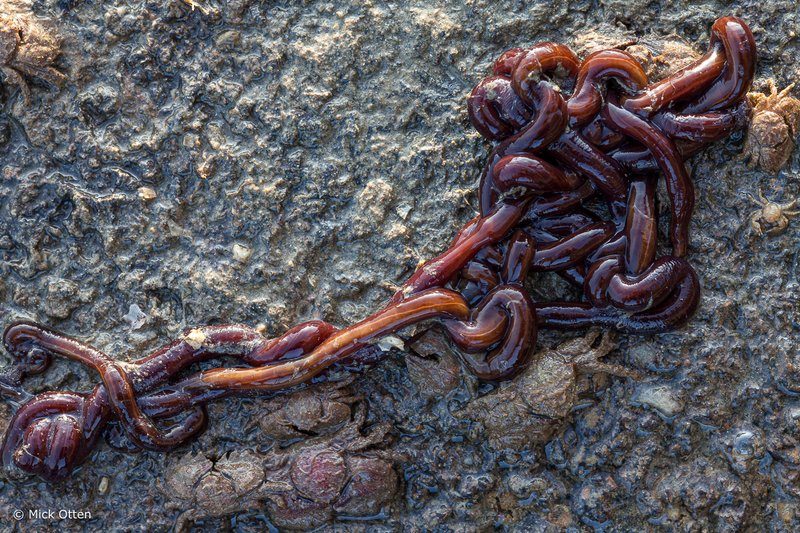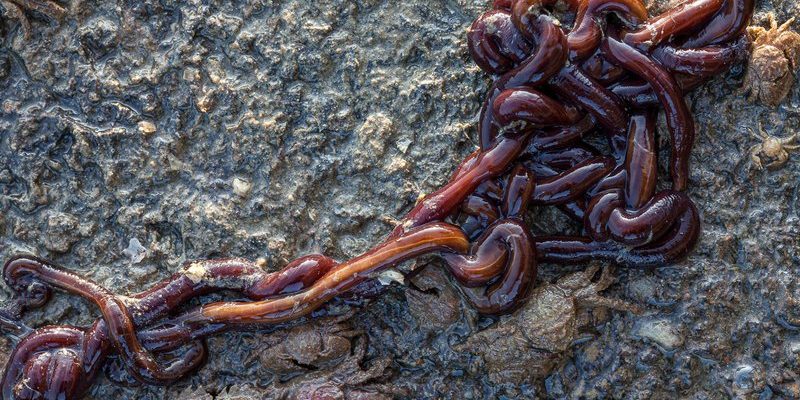
So, how does this work? Bootlace worms, known scientifically as *Lineus longissimus*, are some of the longest creatures on Earth, stretching up to 55 meters in length! Their mucus trails not only help them navigate but also act as a way to leave a mark for others. When you shine UV light on these trails, they fluoresce, revealing a bright path that would otherwise be invisible to the naked eye. This technique isn’t just for fun; it can offer insights into marine biology and the habits of these fascinating worms. Ready to dive deeper? Let’s go!
What Are Bootlace Worms?
Bootlace worms are quite the marvel in the marine world. These long, slender creatures are often found in sandy or muddy environments along coastlines. Thanks to their impressive length and unique anatomy, they can sometimes be mistaken for a sea monster! But don’t worry, they’re harmless. Bootlace worms belong to the phylum Nemertea, which are more commonly known as ribbon worms.
These worms have a powerful retractable proboscis, which they use to catch prey, mainly small crustaceans. Their body is soft and flexible, allowing them to burrow into the sand or mud, creating a perfect hiding spot from predators. As they move through their environment, they leave behind a slimy mucus trail. You might be wondering why this is important. Well, this mucus serves multiple purposes—it helps them glide smoothly through their habitat and even plays a role in reproduction. Isn’t nature clever?
Why Use UV Light?
You might be asking yourself, “Why should I bother with UV light?” Well, here’s the thing: UV light reveals details that are otherwise invisible. When you shine a UV light on bootlace worm mucus trails, the mucus fluoresces, creating a glowing path. This glowing effect helps researchers and enthusiasts alike to track the movement patterns of these worms, providing valuable information about their behavior and habitat.
Additionally, using UV light makes it easier to study these trails without disturbing the environment. Unlike other methods that might involve digging or disturbing the sand, UV light allows for a non-invasive approach. Plus, it can be a fun activity for kids and adults, turning a simple beach outing into a hands-on science experiment. Who wouldn’t want to be a marine detective for the day?
How to Use UV Light to Locate Mucus Trails
If you’re eager to try spotting bootlace worm trails yourself, you’ll need a few items. Here’s how to get started:
- UV flashlight: Purchase a UV flashlight or a black light. They’re quite affordable and can be found at most stores or online.
- Gloves: It’s a good idea to wear gloves to protect yourself from any environmental contaminants.
- A beach or sandy area: Find a place where bootlace worms are known to live, preferably during low tide for easier access.
Once you have your equipment, follow these steps:
1. Look for signs: Before using the UV light, keep an eye out for any slimy trails in the sand; these are good indicators that you’re in the right area.
2. Turn on the UV light: Shine the UV flashlight along the sandy surface. You should start to see glowing trails if any bootlace worm mucus is present.
3. Observe: Take your time to track the trails. Notice their patterns and how they navigate through the sand. This can be a beautiful experience and a learning opportunity.
What to Look For in Mucus Trails
As you explore for these mucus trails, there are a few key features to keep in mind. The color and consistency of the mucus can vary depending on environmental factors. Typically, the trails appear as thin, shiny lines that can curve or twist throughout the sand.
When illuminated with UV light, these trails can exhibit a vibrant glow, often resembling neon colors. In some conditions, the trail might not be as bright, so it’s essential to adjust the angle of your UV flashlight or even the distance to get the best view. Take a moment to appreciate the intricate patterns; each trail tells a story about the bootlace worm’s journey!
Scientific Insights and Applications
Using UV light to locate bootlace worm mucus trails isn’t just a fun activity; it also has scientific significance. Researchers can gather data on the behavior and movement of these worms, which helps us understand their role in the marine ecosystem. For example, studying how these trails connect can shed light on their feeding habits and reproductive strategies.
Additionally, this method of detection can support conservation efforts. By understanding the habitats and behaviors of bootlace worms, we can better protect their environments. Monitoring the health of these ecosystems is crucial for maintaining biodiversity and ensuring the long-term survival of various marine species.
Exploring the natural world, especially with tools like UV light, opens up a new avenue for curiosity and learning. Bootlace worms and their mucus trails are just one example of how nature can surprise us. By using UV light, you not only enhance your understanding of these fascinating creatures, but you also engage in an activity that connects you with the environment.
So next time you’re at the beach or near a muddy area, grab a UV flashlight, and embrace the adventure. You might just uncover a hidden world filled with glowing trails and intriguing stories of life beneath the surface. Happy exploring, and let the mysteries of nature inspire your journey!

